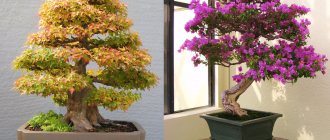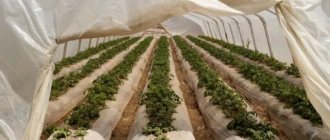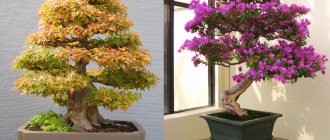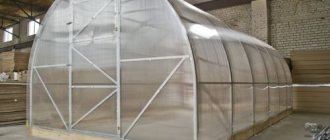Anyone can grow tuberous anemones on their own plot, the main thing is to understand all the intricacies of planting and care. And then, during the summer season, this amazing plant will delight the eye with its bright, charming flowers, the color, shape and size of which can be very diverse.
Which anemones are tuberous?
Anemones are plants belonging to the genus Anemone of the Ranunculaceae family. In total, the genus includes about 150 different species, most of which are rhizomatous plants. There are not so many tuberous anemones; they differ significantly from their close relatives in appearance and cultivation techniques.
The most popular types of tuberous anemones among summer residents and gardeners:
- Crown anemone is considered the most beautiful, but at the same time, the most capricious and demanding to care for tuber variety of the plant. A distinctive feature is large simple or double flowers, reaching 8 cm in diameter. Their color can be very diverse. The height of the bush is up to 45 cm. The plant comes from the Mediterranean and the Middle East, where the climate is very warm. That is why the flower is sensitive even to slight cold snaps. Most often, this type of anemone is grown in greenhouses and also dug up for the winter;
- Garden anemone - has large pink or red flowers, reaching 5 cm in diameter. The height of the bushes usually does not exceed 30 cm. This tuberous anemone is also dug up for the winter;
- Caucasian anemone is extremely unpretentious. Unlike previous species, it does not need to be dug up for the winter. The plant also does not need frequent watering, and it can grow even in open areas. The culture is distinguished by delicate lilac-blue flowers, with a diameter not exceeding 3 cm. The length of the shoots is 10 - 20 cm;
- Tender anemone is another plant that can overwinter in a flower bed. It can withstand frosts down to -25 degrees, is also resistant to drought, and loves well-lit places. The bush reaches a height of 15 cm. Wild species have blue flowers 3-4 cm in size, but there are many garden varieties that feature white, pink, lavender, red or two-color flowers;
- Apennine anemone - has some similarities with the Caucasian anemone, however, in this species the flowers are painted in a pure blue hue, and the length of the shoots is no more than 15 cm. The crop can overwinter in the ground if the temperature in winter remains above -23 degrees. The color and shape of flowers in garden varieties bred from this species can be varied.
Diseases and pests
Anemones rarely get sick or suffer serious pest attacks..
When growing Anemone, you can sometimes encounter root rot. But it arises only under human influence, namely due to uncontrolled watering.
Sometimes slugs or snails settle on Anemones, which spoil the appearance of the flower. A metaldehyde solution will drive away pests for a long time (use strictly according to the instructions). But, of course, the pests that have already appeared will need to be collected manually.
But if the plant has leaf nematodes or winter worms, then most likely you will have to get rid of the damaged bushes, and remove the top layer of soil under them and move it away from healthy Anemones.
How to choose the right tubers
The key to successful cultivation of tuberous anemone is the purchase of high-quality planting material, which can be purchased in specialized flower shops towards the end of winter. Most often, tubers are sold in branded packaging, which contains recommendations for storage and planting dates. As a rule, they have already been treated with fungicides to prevent various diseases.
Important! It is worth choosing tubers made by trusted manufacturers. When purchasing, you must pay attention to the integrity of the packaging and the appearance of the planting material.
As can be seen from the photo, anemone tubers, as a rule, are irregular in shape and have a small size (1 - 3 cm). They look like flattened dried lumps with an uneven surface with tubercles, grooves and growths. Depending on the variety, their color can be brown or dark earthy.
In healthy specimens, the color is uniform, there are no black spots or traces of mold on the surface. They are solid to the touch and there should be no voids inside. When purchasing planting material in a retail chain, it is important to know that it has a fairly low germination rate: out of 5 tubers, usually only one is viable.
Common mistakes
It can be noted that it is very difficult to make a mistake when growing Anemone. This is a truly unpretentious and very persistent flower. In many ways, it grows completely on its own.
Therefore, the main problems are often associated with trying too hard. The easiest way to spoil Anemone is to water it more than normal. Almost always, the moisture it receives from dew and rain is enough for it.
Quite often, Anemone is dug up every time for the winter. Although in mild winters it is enough to simply cover the flowerbed with leaves and greenery from the harvest.
Finally, do not forget that Anemones are quite whimsical in terms of temperature, preferring coolness and a fresh breeze. On the contrary, too sunny and open areas will adversely affect the growth of this plant.
How to plant anemone tubers
Following the rules specified in the article, even a novice gardener can cope with planting anemone tubers. First, you need to decide on the timing of planting, prepare planting material, containers and soil.
When to Plant Anemone Tubers
Anemone tubers should be planted in open ground in the spring, after the soil has warmed up sufficiently. However, in this case, the opening of the tuberous anemone buds should be expected only in mid or late summer. In order for the buds to form earlier, planting material is planted in peat pots in advance, before the onset of spring, and kept in a cool room.
The exact time for planting in open ground varies depending on the region and variety of tuberous anemone. As a rule, the optimal temperature for a flower is a stable temperature of 9 - 12 degrees. Reducing it slows down the rate of rooting, and increasing it negatively affects the development of the young plant.
Selection of container and soil preparation
For planting tuberous anemones, it is not recommended to use the usual plastic and plastic containers, since in this case, during transplantation into open ground, they will need to be removed from it, which can lead to damage to the root system of young plants.
For tuberous anemone, peat pots are ideal as containers, which can be placed directly into the soil with germinated seedlings when planting.
The next step is to prepare the soil for the tuberous anemone; ideally it should be loose and alkaline. You can acidify it by adding ash or dolomite flour.
Advice! Adding peat, coarse river sand or thoroughly rotted manure will help add breathability to the soil.
Soaking anemone tubers
Before growing anemones from tubers, it is necessary to awaken them from sleep by saturating them with moisture. However, it is not recommended to completely immerse them in water. In this case, they will absorb too much liquid and may subsequently rot.
Soaking algorithm:
- pour warm water into a saucer;
- add a drop of root formation stimulants: Zircon, Epin or their analogues (aloe juice is a natural stimulant);
- soak a gauze cloth in the solution and squeeze lightly;
- Wrap the tubers in damp gauze, place in a plastic bag, and keep in this condition for no more than 5 - 6 hours.
Landing rules
Experienced gardeners recommend planting tuberous anemones in two stages, in the first of which germination of planting material occurs, and in the second - growing.
After soaking, pour a small amount of pre-prepared soil into any shallow container, lightly moisten it and lay the tubers on the surface. The container is covered with film or glass and kept at a cool temperature (about 5 degrees), keeping the soil moist. After 8 - 12 days, the first roots and growth points begin to appear. They determine the side on which the tuber is placed in the ground.
After a small sprout hatches, you can begin growing the tuberous anemone in peat pots. If the sprouts have not appeared after the allotted time, the soil substrate continues to be moistened as it dries, being careful not to overdo it. If the tubers have not rotted, they should definitely germinate within another week.
Important! Sprouted tuberous anemones are planted in peat pots, deepened by about 5 cm so that the sprouts look up.
How to care for anemones in pots
The recommended temperature for keeping seedlings is about 12 degrees. High temperatures make the sprouts weak and can cause them to rot. After complete rooting, the increase in temperature ceases to pose a danger to plants.
Further care for tuberous anemone includes moderate regular watering without waterlogging as the soil mixture dries out. In the early stages, the plant does not need feeding.
Preparing seeds before sowing
The seeds of this crop have poor germination (no more than a quarter of the material), so before planting anemones, germination with preliminary stratification is necessary. This concept means simulating wintering conditions without critical temperature drops.
The seeds are placed in a damp sand-peat mixture (1:3) and kept warm for several days until they swell. After this, the soil substrate is moistened again, its volume is slightly increased and the container is moved to a cooler place for a few more days. During this time, the seeds should hatch. And finally, the container with the seeds is sent “for wintering” to a cold place. It is best to bury the container in the ground and cover the top with insulating materials and then with snow.
In the spring, you need to dig up the container as soon as the ground thaws, and plant the anemone seeds for seedlings.
You should know! When propagated by self-collected seeds, the color of the resulting plants is paler than that of the mother plant.
Planting anemones in open ground
The place for planting tuberous anemones should be protected from drafts; the recommended light level for different varieties may be different. The requirements for the soil are exactly the same - it must be loose, breathable, fertile and, preferably, alkaline.
Before planting in open ground, first dig up the area, removing all pebbles and weed roots. Tuberous anemones have a negative attitude towards stagnant water in the soil, so they are not placed in damp places, and planting holes are drained before planting. Crushed stone, gravel or broken red brick are perfect for drainage.
The easiest way is to plant tuberous anemones in open ground, pre-sprouted in peat pots: in this case, they will simply need to be placed together with the pot itself in planting holes located at a distance of at least 20 cm from each other.
When planting tubers directly into the ground, there is no need to additionally germinate them after soaking. The recommended distance between plants remains the same. Planting scheme - depending on the size of the tubers:
- 1 cm – 50 pcs. per 1 sq. m;
- 1.5 cm – 20 – 30 pcs. per 1 sq. m;
- 2 cm – 20 – 25 pcs. per 1 sq. m.
It is recommended to bury tubers measuring 1 - 1.5 cm into the soil by 4 - 5 cm, larger specimens - by 8 - 10 cm. Planting algorithm:
- make holes about 15 cm deep;
- put some humus and ash on the bottom;
- place the tuber so that the flat growing point is directed upward and the sharp end is directed downward (if in doubt, you can plant it on its side);
- sprinkle with earth.
It is necessary that the soil is well moistened. The first shoots should be expected in 20 - 25 days.
Answers to popular questions
When is the best time to plant?
It all depends on the variety. Most Anemone species are ready for planting in mid-spring. Some can be planted in summer to achieve fall flowering.
At home, Anemone can be planted even in winter in order to enjoy the first flowers in early spring.
When are anemones dug up for the winter?
At the end of autumn. The ideal situation is that the plant has completely bloomed and has begun to shed its leaves.
How to collect seeds?
Many Anemone species are self-seeding. To collect seeds, it is recommended to dig boxes with fertilized soil next to the flowerbed while the bushes are flowering. Seeds will naturally fall into it.
For the winter, the box is placed in a warm, but not hot place. In spring you can already expect the first shoots to appear.
Which side to plant and how to determine top and bottom?
Anemone tubers should be planted with their growth point facing upward. Everyday advice says that most of these points are on the flat side of the tuber. This means that the opposite, sharp part should be directed downwards.
Caring for anemone in the ground
Caring for tuberous anemone in the ground is simple. Timely application of fertilizing is the key to lush and abundant flowering. During the formation of buds, the plant needs organic fertilizing, and in the fall - complex mineral fertilizers. If all the necessary fertilizers were added to the soil during planting, additional fertilizing is not necessary.
Important! Fresh manure cannot be used to feed tuberous anemones.
Watering
In spring, the tuberous anemone is watered once a week. In hot and dry summer weather, it is recommended to water daily, early in the morning and in the evenings after sunset. If the summer turns out to be rainy, watering is reduced, based on soil moisture. The main thing is to remember that waterlogging, like drought, is detrimental to the plant.
Loosening and weeding
Since tuberous anemones have a shallow root system, loosening the soil around them with a hoe or flat cutter is strictly prohibited, so weeding is done by hand. To ensure that fewer weeds grow around the plants, the soil around can be mulched with a layer of peat or dry mullein.
Flowering conditions
In general, Anemone begins to bloom quite early even without thorough care. Some varieties even bloom twice a year.
What you will need to especially watch out for is:
- So that the bushes are planted in partial shade. Too much sun can harm the plant. As well as the complete absence of sunlight - too.
- Do not overdry the soil near the bush. If necessary, water additionally as needed.
- Monitor the appearance of pests and remove them in a timely manner (remove them manually).
Otherwise, you can cope with care even without serious experience under your belt. So most of the planted Anemone bushes are sure to bloom.
Growing rhizomatous anemones or propagating them by division
It is optimal to divide the rhizomes in the spring. This is explained by the fact that during this period the movement of sap inside the plant is somewhat slower, which means the flower will be able to take root normally after division.
Note! Propagation by dividing rhizomes should be performed only with anemones older than 4-5 years.
What needs to be done to divide anemone rhizomes:
- Dig up the rhizomes yourself.
- Cut into pieces 5-6 centimeters long and each with at least one, and preferably several, renewal buds.
- Plant horizontally in a previously prepared hole to a depth of the same 5-6 centimeters.
Description of the plant
Windmill, anemone, daughter of the winds - the genus of perennial anemone mainly belongs to the Ranunculaceae family, but some of its species also belong to the Lumbaceous family.
The natural habitat is lands in both hemispheres of the planet with a temperate climate, mainly in mountainous areas: Russia, Norway, Alaska, Canada and even the Arctic.
In addition to mountains, you can find them:
- in deciduous forests;
- along the edges;
- in parks;
- in the tundra;
- on grassy slopes and dry hills;
- in damp mountain valleys;
- in shady lawns;
- on subalpine and steppe meadows.
The main difference between all species in the genus is in the root - some plants have a tuberous root, and some have a regular rhizome. Plants with rhizomes are well suited for beginning gardeners - they are easy to care for and not fussy. Whereas, with a tuberous root, on the contrary, they are capricious and require special care - which is good for developing gardening skills.
In total, today there are about 170 species in the genus and according to the flowering period they are divided into autumn, spring and summer. During the flowering period, all stems become peduncles with the exception of young stepsons. There is no greenery near the roots and up to the middle of the stem. Closer to the top there are usually three medium-sized cup-shaped leaf plates. Flower petals come in green, white, purple, yellow, blue, pink and red colors. The flowers themselves are bisexual, with numerous stamens and pistils.
Some species have medicinal properties. And in ancient times, in the territory of modern Magadan Region, Chukotka and Kamchatka Territory, the local population used anemone to prepare poison.
Choosing a landing site
Most varieties of anemone cannot tolerate direct sun; slightly shaded areas are needed for planting anemones. The optimal area for placing spectacular decor is the area under trees with a sparse crown to avoid deep shadow. Mediterranean varieties: tender and crown anemones, on the other hand, grow well in sunny locations. Early spring species (Altai, flexible, smooth, buttercup) love shade.
The soil should be nutritious, but loose, with a mandatory content of sand. Some species prefer alkaline soil, most varieties prefer neutral and slightly acidic soil. Wetlands, like an arid climate, are extremes that are not conducive to the active growth and flowering of anemone in summer cottages.
Medicinal properties
The anemone flower is used in folk medicine due to its properties:
- has an antifungal effect;
- stops the growth of cancer cells;
- thins the blood, strengthens blood vessels;
- has anti-inflammatory and disinfecting properties.
Infusions are used for cardiovascular diseases, pneumonia, and pathologies of the digestive system. When using anemone-based products, you need to be extremely careful, because it is toxic. It is recommended to consult with specialists in advance to avoid harm to health.
Careful wintering
The entire variety of anemone varieties is divided into two groups according to the nature of the roots. Rhizomatous plants overwinter well in the garden even in the middle zone; it is enough to cover them with sawdust, fallen leaves or peat, plus there should be plenty of snow.
Tuberous plants come from the southern regions of Europe, which explains their painful sensitivity to sub-zero temperatures. The exceptions are the Apennine, tender and Caucasian anemones, which can overwinter under mulch and spruce branches.
All other tuberous anemones are dug up. It is optimal to do this from mid-September to early October on a clear, dry day. The dug up tubers are cleaned of soil, if desired, disinfected and necessarily dried at +20 ° C, spread out in one layer.
Then, until the end of winter, the tubers are removed in containers with sand or sawdust and stored at +3...4 °C.
In conclusion, it is worth adding that in recent gardening seasons a trend has been gaining popularity - decorating rocky hills with anemones, where they are perfectly combined with low-growing evergreen shrubs.











